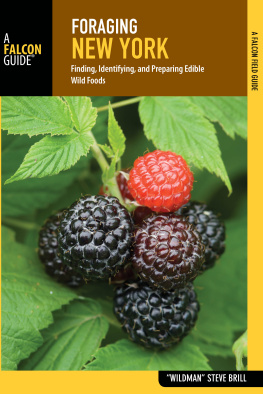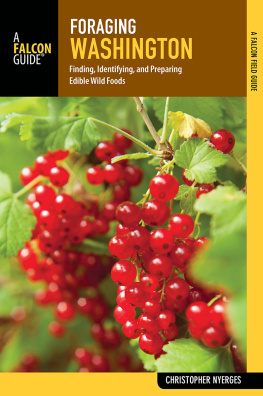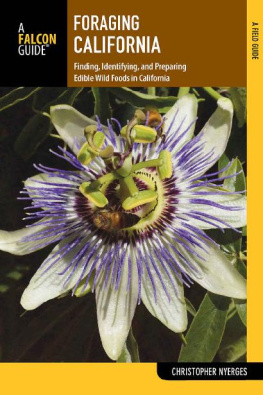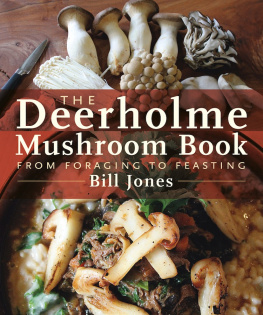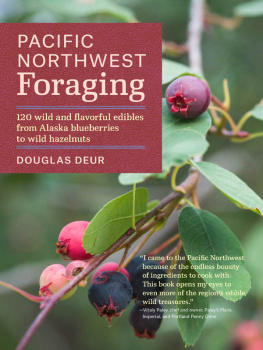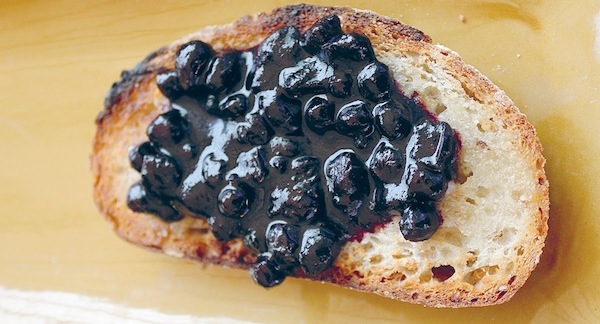A NOTE ABOUT PESTO
Making a pesto is a great way to preserve a bountiful harvest of wild herbs and plants. Pesto is an Italian technique that has its root in the word pestare (to pound or grind). Ancient Romans ground cheese, garlic, and herbs into a paste called moretum. In the more modern age, this commonly took the form of basil pured with pine nuts, garlic, and cheese (the classic Pesto Genovese). Modern chefs take it to mean any pure of herbs or plants mixed with oil and seasoning. For a nuttier pesto, you can add 2 cups (500 mL)of roasted hazelnuts or sunflower seeds to the mix. You may have to add a little extra oil to make a smooth and soft pesto. Here are several wonderful variations based on foraged foods.
STINGING NETTLE PESTO
Use gloves to collect the nettles and take only the top tips of the plant. Pick before the plant has flowered. Blanched nettles can be frozen for up to 2 months; vacuum pack for even longer storage life in the freezer.
8 cups (2 L) stinging nettle tips
1 tsp (5 mL) vitamin C (such as Bernardin Fruit Fresh canning powder) (optional)
cup (125 mL) extra-virgin olive oil
1 tsp (5 mL) sea salt
1 tsp (5 mL) hot sauce
Soak the stinging nettle tips in plenty of cold water. Rinse and drain. Bring a large pot of salted water (16 cups [4 L]) to a boil over high heat. Add the nettles and cook for 30 seconds, or until the nettles are limp and dark green. Remove the nettles from the pot with a slotted spoon or tongs and transfer to a large bowl of cold water. Shock (chill) the nettles to stop the cooking process. Drain the nettles and squeeze out all moisture. You will end up with a softball-sized lump of nettles.
In a food processor (or using mortar and pestle if you go old school), add the drained nettles and pulse to chop up. Pure to a paste, adding the vitamin C (if using) and then the oil in a slow and steady stream. You should have a smooth paste at this point. Season with salt and hot sauce to taste. Pure until smoothly mixed. Transfer to a storage container to refrigerate for 1 week, or freeze for up to 3 months.
MAKES ABOUT 2 CUPS (500 mL)
Wild Greens Variations:
8 cups (2 L) oxeye daisy leaves and unopened buds
8 cups (2 L) miners lettuce leaves and stems
8 cups (2 L) lambs quarters leaves and stems
2 cups (500 mL) wild onions
MUSHROOM PESTO
Use clean wild or cultivated mushrooms. Very carefully trim the mushrooms of any dirt and rinse under cold running water. Drain well and use immediately. This recipe works with many mushrooms, most successfully with chanterelles and boletes.
2 Tbsp (30 mL) grapeseed oil
1 cup (250 mL) peeled and chopped onions
8 cups (2 L) wild mushrooms (can be a blend)
2 Tbsp (30 mL) chopped fresh garlic
2 Tbsp (30 mL) chopped fresh sage
2 Tbsp (30 mL) chopped fresh parsley
2 Tbsp (30 mL) chopped fresh rosemary
cup (125 mL) extra-virgin olive oil
1 tsp (5 mL) sea salt
1 tsp (5 mL) hot sauce
Warm a frying pan over high heat and add the grapeseed oil. When very hot, add the onions and saut until they begin to soften. Add the mushrooms and season with salt and pepper. The mushrooms should immediately release moisture. Add the garlic, sage, parsley, and rosemary to the pan. Saut until all the moisture is evaporated and the mushrooms begin to stick to the bottom of the pan. Transfer to a bowl and allow to cool slightly.
In a food processor, add the mushroom mixture and pulse to chop up. Pure to a paste, adding the olive oil in a slow and steady stream. You should have a smooth paste at this point. Season with salt and hot sauce to taste. Pure until smoothly mixed. Transfer to a storage container to refrigerate for 1 week, or freeze for up to 3 months.
MAKES ABOUT 2 CUPS (500 mL)
SEAWEED PESTO
You can make this pesto equally well with fresh seaweed or dried seaweed that you have reconstituted. Simply soak the dried seaweed in cold water to refresh before using. My favourite seaweeds for this pesto are the softer varieties of laver (nori).
4 cups (1 L) chopped seaweed leaves
1 cup (250 mL) toasted sunflower seeds
1 Tbsp (15 mL) chopped garlic
cup (125 mL) grapeseed oil
2 Tbsp (30 mL) light miso paste
1 tsp (5 mL) sea salt
1 tsp (5 mL) hot sauce
Heat a stockpot of water over high heat. Add the seaweed and cook for 1 minute, or until the seaweed softens. Drain and allow to cool slightly.
In a food processor, add the seaweed, sunflower seeds, and garlic. Pulse to chop up. Pure to a paste, adding the oil in a slow and steady stream. You should have a smooth paste at this point. Season to taste with miso, salt, and hot sauce. Pure until smoothly mixed. Transfer to a storage container to refrigerate for 1 week, or freeze for up to 3 months.
MAKES ABOUT 2 CUPS (500 mL)
BLUEBERRY JAM
This is the basic technique for making most types of jam. Sugar is a great preservative and is needed for the proper set and for creating jam that is safe to use months down the road. It is important to use the quantities of sugar indicated. If you do not, keep the jam refrigerated or frozen until use. These recipes use a little less sugar than traditional recipes due to the use of liquid pectin as a thickening agent. Do not substitute powdered pectin for these recipes.
6 cups (1.5 L) blueberries, washed and rinsed
2 Tbsp (30 mL) lemon juice
4 cups (1 L) granulated sugar
1 tsp (5 mL) butter
2 pouches (170 mL) liquid pectin (such as Bernardin)
Heat a large, deep stainless steel saucepan over medium and add the blueberries. Crush with a potato masher. Stir in the lemon juice, sugar, and butter. Bring to a boil. Add the pectin and return to a boil for 1 minute, stirring constantly. Remove from the heat and skim off any foam.
Ladle the hot jam into a hot jar to within inch (0.6 cm) of the top of the jar. Tap the jar to remove any air bubbles. Wipe the jar rim to remove any jam residue. Place a lid on the clean jar rim. Screw the band down until resistance is met, then increase to gently tighten. Return the filled jar to the rack in the canner. Repeat for remaining jam.
When all the jam is used up and the jars are in the canner, make sure the jars are covered by at least 1 inch (2.5 cm) of water. Cover the canner and bring the water to a full, rolling boil, processing for a full 10 minutes. Turn the stove off, remove the canner lid, wait 5 minutes, then remove the jars without tilting, and place them upright on a cooling rack. Cool upright, undisturbed for at least a day.
Check each jar for a good seal. Sealed discs curve downward and do not move when pressed. Remove the screw bands; wipe and dry the bands and jars. Store the screw bands separately or replace loosely on the jars, as desired. Label and store the jars in a cool, dark place. For best quality, use the jam within 1 year. Any jars that have not sealed properly should be stored in the refrigerator.
MAKES ABOUT 4 CUPS (1 L)
Fruit Variations:
Use the same measurements of lemon juice, sugar, butter, and pectin as indicated above unless other variations are specified.
6 cups (1.5 L) strawberries
6 cups (1.5 L) blackberries (crush the fruit and add an equal amount of sugar; use only 1 pouch of pectin)
6 cups (1.5 L) huckleberries (crush the fruit and add an equal amount of sugar; use only 1 pouch of pectin)



